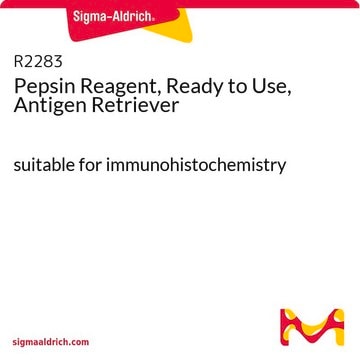This falls under the research grade.
P7125
Pepsin from porcine gastric mucosa
powder, ≥400 units/mg protein
Synonym(s):
Pepsin A, Pepsin from hog stomach
About This Item
Recommended Products
biological source
Porcine gastric mucosa
Quality Level
form
powder
specific activity
≥400 units/mg protein
mol wt
35 kDa
solubility
10 mM HCl: soluble 1.0 mg/mL, clear to faintly turbid, colorless
UniProt accession no.
storage temp.
2-8°C
Gene Information
pig ... LOC396892(396892)
Looking for similar products? Visit Product Comparison Guide
Related Categories
Application
Biochem/physiol Actions
Pepsin is the major proteolytic enzyme produced in the stomach. It digests proteins through the cleavage of interior peptide linkages.[8]
Unit Definition
Analysis Note
Other Notes
inhibitor
Signal Word
Danger
Hazard Statements
Precautionary Statements
Hazard Classifications
Eye Irrit. 2 - Resp. Sens. 1 - Skin Irrit. 2 - STOT SE 3
Target Organs
Respiratory system
Storage Class Code
11 - Combustible Solids
WGK
WGK 1
Flash Point(F)
Not applicable
Flash Point(C)
Not applicable
Personal Protective Equipment
Choose from one of the most recent versions:
Certificates of Analysis (COA)
Don't see the Right Version?
If you require a particular version, you can look up a specific certificate by the Lot or Batch number.
Already Own This Product?
Find documentation for the products that you have recently purchased in the Document Library.
Customers Also Viewed
Protocols
This procedure may be used for determination of Pepsin activity using hemoglobin as the substrate. It is a spectrophotometric stop rate determination.
-
Can you please tell me the Grade of this product?
1 answer-
Helpful?
-
-
Hi, What is the shelf life for this product? Thanks
1 answer-
This product is not assigned an expiration date or recommended retest date. Products with no expiration date or recommended retest date should be routinely inspected by customers to ensure they perform as expected. These products are also subject to a one year warranty from the date of shipment. For more information you may access the "Product Dating Information" document under "ADDITIONAL USEFUL DOCUMENTS ABOUT OUR PRODUCTS" at the bottom of the Quality Services page with this link: https://www.sigmaaldrich.com/life-science/quality-and-regulatory-management/quality-services.
Helpful?
-
-
Which Pepsin do you recommend for histology/antigen retrevial? According to protocol 0.2mg/ml in 0.2M HCL
1 answer-
This product has not been specifically qualified for antigen retrieval, however, it may be able to be qualified for use by the end user. A typical protocol using pepsin for antigen retrieval suggests the following stock and working solutions:
Pepsin Stock Solution (1% in 10mM HCl):
Pepsin ------------------------------------- 100 mg
10mM HCl (pH 2.0) ---------------------- 10 mlMix to dissolve. Store at -20 ºC
Pepsin Working Solution (0.5% in 5mM HCl):
Pepsin Stock Solution (0.5%) ------------ 1 ml
Distilled water ---------------------------- 1 mlMix well.
For antigen retrieval - cover sections with pepsin working solution and incubate for 10-20 minutes at 37 °C in humidified chamber (optimal incubation time may vary depending on tissue type and degree of fixation, and should be determined by user).
Product R2283 is a pepsin product qualified for antigen retrieval https://www.sigmaaldrich.com/product/sigma/r2283.
For more information, please see the following link: https://www.sigmaaldrich.com/technical-documents/protocol/protein-biology/immunohistochemistry/immunohistochemistry-protocol#antigen_retrieval.
Helpful?
-
Active Filters
Our team of scientists has experience in all areas of research including Life Science, Material Science, Chemical Synthesis, Chromatography, Analytical and many others.
Contact Technical Service












